Hello everyone. I got an idea looking at Peter Morris PM90 speaker if it could be used as line array cabinet with appropriate waveguide, then someone has offer "half" version of it with only one 12" and I really like it.
My idea is that single 12" design tilted to side.
Like a small line array high-end cabinet with fixed angles using coaxial dcx464 on "DOSC" waveguide crossed at 650Hz, together with mb12n405 on folded horn of PM90.
It could be active powered by DigiMod 3004pfc4 using two channel in bridge 1x3000w for mb12n405 and other 2 channel 2x1000w for dcx464.
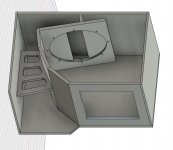 Here is the pic of how it should look being only 650mm wide, array should consist of up to 5 cabinet with 5* to 20* angle for each cabinet with all 5 cabinets making vertical dispersion angle of about 62* and horizontal, it should be about 100*.
Here is the pic of how it should look being only 650mm wide, array should consist of up to 5 cabinet with 5* to 20* angle for each cabinet with all 5 cabinets making vertical dispersion angle of about 62* and horizontal, it should be about 100*.
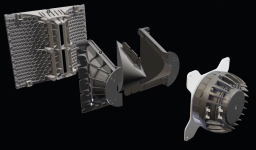 Regarding waveguide, something similar has been used in VIO L1610 crossed with dcx464 at about 500Hz as their specs tell.
Regarding waveguide, something similar has been used in VIO L1610 crossed with dcx464 at about 500Hz as their specs tell.
This is just an attempt to connect two designs into one from a person that doesnt have much knowledge about designing speakers, so I would kindly request a help to see if this design have any potential.
Let's assume that the dcx464 would work well on such a horn from example of the VIO L1610. What would be advantages and disadvantages of mb12n405 midbass arrayed 2-5 cabinets on each side above dual 18" subs for live sound reinforcement? Will it have same quality, coverage pattern and possible lower crossover point to subs compared to PM90 or single 12" design may not work that good ?
Volume for the 12” would be about the same as in PM90 speaker.
My idea is that single 12" design tilted to side.
Like a small line array high-end cabinet with fixed angles using coaxial dcx464 on "DOSC" waveguide crossed at 650Hz, together with mb12n405 on folded horn of PM90.
It could be active powered by DigiMod 3004pfc4 using two channel in bridge 1x3000w for mb12n405 and other 2 channel 2x1000w for dcx464.
 Here is the pic of how it should look being only 650mm wide, array should consist of up to 5 cabinet with 5* to 20* angle for each cabinet with all 5 cabinets making vertical dispersion angle of about 62* and horizontal, it should be about 100*.
Here is the pic of how it should look being only 650mm wide, array should consist of up to 5 cabinet with 5* to 20* angle for each cabinet with all 5 cabinets making vertical dispersion angle of about 62* and horizontal, it should be about 100*. Regarding waveguide, something similar has been used in VIO L1610 crossed with dcx464 at about 500Hz as their specs tell.
Regarding waveguide, something similar has been used in VIO L1610 crossed with dcx464 at about 500Hz as their specs tell.This is just an attempt to connect two designs into one from a person that doesnt have much knowledge about designing speakers, so I would kindly request a help to see if this design have any potential.
Let's assume that the dcx464 would work well on such a horn from example of the VIO L1610. What would be advantages and disadvantages of mb12n405 midbass arrayed 2-5 cabinets on each side above dual 18" subs for live sound reinforcement? Will it have same quality, coverage pattern and possible lower crossover point to subs compared to PM90 or single 12" design may not work that good ?
Volume for the 12” would be about the same as in PM90 speaker.
Last edited:
For sound reinforcement, it can give you greater output to use many.
Maintaining coverage is also a way to increase output. I have two questions..
1. What is the reason for your interest in the line array? and..
2. Are you considering the fact that a line array and a horn are in a sense the same thing?
Maintaining coverage is also a way to increase output. I have two questions..
1. What is the reason for your interest in the line array? and..
2. Are you considering the fact that a line array and a horn are in a sense the same thing?
AllenB
1. From some experience in sound reinforcement I can tell line array is mostly used and preferred design both from technicians and from the organizers of events. Its very popular nowdays.
I think a line array with fixed angles is the best of both worlds, having clarity of point source while keeping uniform front to back SPL at much bigger audience.
From experience I can tell such fixed angle line array can also contribute to reducing reflections because you can still put right cabinets to adjust vertical dispersion angle a bit and in that way lets say avoid the opposite wall in a hall while covering all audience in front with same SPL.
With point source you should be very lucky if you have just right vertical dispersion from your horn to cover audience from that height of your truss.
Big advantage is also that we can divide such system in 2 or 3 groups of 2-3 cabinets and cover few smaller events at the same time.
Have worked once with a team that have just put one L’A A15 box with a 10* vertical angle per side for a small show while using the rest of their system at different place at the same time for example.
2. Am considering the fact that fixed angle line array with constant curvature waveguide is essentially an attempt to make one larger horn from several separate units that are complete and can work as individual speakers too.
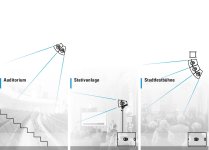
Not sure what you think since adjustable angle line arrays often have issue with lobbing of multiple cabinets and loss of clarity.
I understand that we couple them for better directivity and greater acoustic output and that they achieve that better at lower frequencies and worse with higher, probably because of longer wavelenght at lower frequencies and horns being split more that 1/2 wavelenght apart.
Thats one thing why I prefer fixed angle line array.
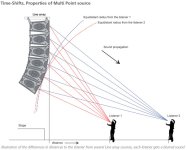
1. From some experience in sound reinforcement I can tell line array is mostly used and preferred design both from technicians and from the organizers of events. Its very popular nowdays.
I think a line array with fixed angles is the best of both worlds, having clarity of point source while keeping uniform front to back SPL at much bigger audience.
From experience I can tell such fixed angle line array can also contribute to reducing reflections because you can still put right cabinets to adjust vertical dispersion angle a bit and in that way lets say avoid the opposite wall in a hall while covering all audience in front with same SPL.
With point source you should be very lucky if you have just right vertical dispersion from your horn to cover audience from that height of your truss.
Big advantage is also that we can divide such system in 2 or 3 groups of 2-3 cabinets and cover few smaller events at the same time.
Have worked once with a team that have just put one L’A A15 box with a 10* vertical angle per side for a small show while using the rest of their system at different place at the same time for example.
2. Am considering the fact that fixed angle line array with constant curvature waveguide is essentially an attempt to make one larger horn from several separate units that are complete and can work as individual speakers too.

Not sure what you think since adjustable angle line arrays often have issue with lobbing of multiple cabinets and loss of clarity.
I understand that we couple them for better directivity and greater acoustic output and that they achieve that better at lower frequencies and worse with higher, probably because of longer wavelenght at lower frequencies and horns being split more that 1/2 wavelenght apart.
Thats one thing why I prefer fixed angle line array.

Last edited:
The asymmetrical bass horn will point to the right, and I'd doubt it would be 100 degrees wide in it's upper range.Hello everyone. I got an idea looking at Peter Morris PM90 speaker if it could be used as line array cabinet with appropriate waveguide, then someone has offer "half" version of it with only one 12" and I really like it.
My idea is that single 12" design tilted to side.
View attachment 1406848Here is the pic of how it should look being only 650mm wide, array should consist of up to 5 cabinet with 5* to 20* angle for each cabinet with all 5 cabinets making vertical dispersion angle of about 62* and horizontal, it should be about 100*.
Will it have same quality, coverage pattern and possible lower crossover point to subs compared to PM90 or single 12" design may not work that good ?
The center to center spacing between the LF & HF is too great (over 1/4 wavelength) for even off-axis horizontal response through the crossover region of 500-650Hz.
If you do decide on an asymmetrical design, make sure the rigging is designed to be able to mirror image the L/R hangs.
You might consider a "W" fold, with narrow bass horn exits on either side of the HF horn to correct the problems inherent in your proposal.
Art
For exampleThe asymmetrical bass horn will point to the right, and I'd doubt it would be 100 degrees wide in it's upper range.
It could be active powered by DigiMod 3004pfc4 using two channel in bridge 1x3000w for mb12n405 and other 2 channel 2x1000w for dcx464.
While I can't speak to your local laws, I'd caution that you may want to examine liability issues when flying cabinets that are homemade. A lawyer may be able to help you decide if undertaking engineering your own cabinets is worthwhile, maybe talking to a friendly insurer off the record would be a good idea as well.
At the minimum, I'd expect that you would need to approach and hire an engineer to design and certify your rigging bracketry, along with detailed cabinet drawings. You may need to perform 3rd party drop tests of completed cabinets and brackets to satisfy an insurer.
Have a look at this link before you proceed. https://www.prosoundweb.com/defying...es-and-best-practices-in-flying-loudspeakers/
No one has ever died from poor sound quality, but many have died from poor rigging.
Once I asked Peter exact same question about his PM90 and as I remember he said somethink like it doesnt matter much in that design.The center to center spacing between the LF & HF is too great (over 1/4 wavelength) for even off-axis horizontal response through the crossover region of 500-650Hz.
Does is mean MTM dipole configuration is less prone to this issue?
Not problem to design a rigging that way but what you think about making bass horn flares symmetrical, it will make box wider but will it help with dispersion?If you do decide on an asymmetrical design, make sure the rigging is designed to be able to mirror image the L/R hangs.
Asymmetrical desing could be desired in case of narrow horizontal dispersion.
Diyuser2010
Ofcourse would demand safety certificate for rigging and took further steps for security and legal obligations.
Safety is on first place.
Last edited:
Can you show me what you mean by this Art ? I cant see how it could be done without drastically increasing the cabinet dimensions.You might consider a "W" fold, with narrow bass horn exits on either side of the HF horn to correct the problems inherent in your proposal.
Art
The cabinet doesn't have to be designed strictly as I presented it. It's only important that with as few as 2-3 cabinets it reaches decent spl at low end, about 80hz to blend nicely when arrayed 2 meters above the double 18 subs.
The best possible sound quality and a good coupling between the cabinets is desirable.
Here is other example that may use 15” 15ntlw3500 and dcx464 lets say?
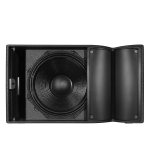
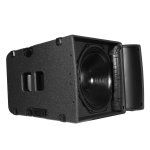
The best possible sound quality and a good coupling between the cabinets is desirable.
Here is other example that may use 15” 15ntlw3500 and dcx464 lets say?


Certainly less of a problem in that the vertical MTM puts the lobes and nulls in the vertical, rather than horizontal.Once I asked Peter exact same question about his PM90 and as I remember he said somethink like it doesnt matter much in that design.
A dipole "figure of 8" configuration isn't applicable to the typical line array.Does is mean MTM dipole configuration is less prone to this issue?
A "W" fold would put the LF driver behind the HF, so would increase the depth.Can you show me what you mean by this Art ? I cant see how it could be done without drastically increasing the cabinet dimensions.
That said, a Paraline throat adapter is only ~18mm depth, and does the same thing as the deeper "VDOSC" and others that are 130mm or more.
The split horn path would need to be no wider than the horn in the OP to retain the same FC, the cabinet width and height could remain the same.
Two meters is barely above head height, a lot more vertical distance is needed if your goal is even front to back audience coverage. If you are using only 2-3 cabinets, you are spending way too much on HF, one DCX464 can keep up with 2x12".It's only important that with as few as 2-3 cabinets it reaches decent spl at low end, about 80hz to blend nicely when arrayed 2 meters above the double 18 subs.
If you plan to expand past 2-3 cabinets, the upper HF should be ~ half the vertical dispersion of the ~20 degree appropriate for 2-3.
My suggestion would be a pair of splayed PM-60 per side (probably keep up to more than 8 x18" front loaded subs), and hire in line arrays for the shows that would benefit from them.
There is no shortage of designs like that...Here is other example that may use 15” 15ntlw3500 and dcx464 lets say?
Weltersys
That W design with paraline looks very interesting, but now it has additional complications.
Somehow I have doubt in paraline waveguides with all those sharp edges, also considering a need to make them in different size and shape and loading down to 650hz I think it would not finish very well.😄
Two meters above sub, so about 3 meters from the floor and higher with more cabinets than 2-3.
Have no choice with a driver that fine and with ability to play that low.
I guess driving it at 70% of power would be nothing bad.
First idea was few different angle cabinets but now am thinking about bottom cabinet being 30* and other 10* like L’A A15 from the pictures.
In that case I could get away with fewer cabinets.
Those boxes with custom 15ndl88 for L’A are killers even 3 per side.
Not sure what role amp is playing, but they say everything is in their amplifier and that with some other sound is weak and bad.
I was thinking about pm90 alot, but everything considered I dont find it worth of investing because already have small point source, even if its best speaker.
What you think about that design?
Are some build already available?
That W design with paraline looks very interesting, but now it has additional complications.
Somehow I have doubt in paraline waveguides with all those sharp edges, also considering a need to make them in different size and shape and loading down to 650hz I think it would not finish very well.😄
Two meters above sub, so about 3 meters from the floor and higher with more cabinets than 2-3.
Have no choice with a driver that fine and with ability to play that low.
I guess driving it at 70% of power would be nothing bad.
First idea was few different angle cabinets but now am thinking about bottom cabinet being 30* and other 10* like L’A A15 from the pictures.
In that case I could get away with fewer cabinets.
Those boxes with custom 15ndl88 for L’A are killers even 3 per side.
Not sure what role amp is playing, but they say everything is in their amplifier and that with some other sound is weak and bad.
I was thinking about pm90 alot, but everything considered I dont find it worth of investing because already have small point source, even if its best speaker.
What you think about that design?
Are some build already available?
From what I understend, they tell double n351 is more than enough to keep up with dcx464 so n405 with 2db more should be ok I guess.If you are using only 2-3 cabinets, you are spending way too much on HF, one DCX464 can keep up with 2x12".
This looks pretty dope when think more about it, but will it have the same problem with narrow horizontal dispersion because of dipole output, same as PM90.A "W" fold would put the LF driver behind the HF, so would increase the depth.
That said, a Paraline throat adapter is only ~18mm depth, and does the same thing as the deeper "VDOSC" and others that are 130mm or more.
View attachment 1407266
The split horn path would need to be no wider than the horn in the OP to retain the same FC, the cabinet width and height could remain the same.
Maybe not if box is only 65cm wide? But then mid horns would not have much of the expansion at mouth and low end extension because of it?
The response of Paralines is not without issues, but low frequency loading is not one of them.Somehow I have doubt in paraline waveguides with all those sharp edges, also considering a need to make them in different size and shape and loading down to 650hz I think it would not finish very well.😄
The cabinet is 26.5"(67.3 centimeters) wide, 11.25"(28.6 centimeters) tall.
I obviously think the PM90 and PM60 are good point source designs, or I wouldn't recommend them.I was thinking about pm90 alot, but everything considered I dont find it worth of investing because already have small point source, even if its best speaker.
What you think about that design?
Are some build already available?
No idea if any are available.
The PM90 does not have a dipole (figure of 8) radiation pattern, and it's lobes are in the vertical, not horizontal orientation.This looks pretty dope when think more about it, but will it have the same problem with narrow horizontal dispersion because of dipole output, same as PM90.
As you can see above, no lack of low end in the high frequency 67cm wide Paraline, its multiple entry horn (MEH) could have been made smaller if it was not also carrying the 8" drivers.Maybe not if box is only 65cm wide? But then mid horns would not have much of the expansion at mouth and low end extension because of it?
The Paraline boxes were converted from front loaded 8":
The center to center distance between the front loaded 8" caused an off axis null around the crossover point, which was eliminated using the MEH approach, based on the VTC EL210.
Art
How low do you cross your synergy with sub?
Does the reason of ragged Paraline response lie perhaps in the thing that maybe no one has done a good job building it in Diy?
As the Todd said you cant expect good results jig sawing it and also that Paraline can be one of the best measuring horns if done right.
Maybe we could get better response if its made out of aluminium on a cnc machine with tolerances less than a thou and with more attempts to further improve it.
Seems worth it for a waveguide with such a compact size for cabinet designing if can sound great.
Does the reason of ragged Paraline response lie perhaps in the thing that maybe no one has done a good job building it in Diy?
As the Todd said you cant expect good results jig sawing it and also that Paraline can be one of the best measuring horns if done right.
Maybe we could get better response if its made out of aluminium on a cnc machine with tolerances less than a thou and with more attempts to further improve it.
Seems worth it for a waveguide with such a compact size for cabinet designing if can sound great.
Last edited:
I think you are right with this but I have a problem with dsp since wanted to go all active and seems there is no good plate dsp for this quality of speaker.My suggestion would be a pair of splayed PM-60 per side (probably keep up to more than 8 x18" front loaded subs), and hire in line arrays for the shows that would benefit from them.
Plate amps from Hypex are already chosen but am stuck now because separate rack with profi dsp is additional piece of gear with possibility of being damaged or stolen. Would also mean 2x xlr for each pm90 because AES3 carry only 2channels of needed 3 per side.
Can someone tell if this Nilai amp in dual channel is enough to drive dcx464 to its full potential.
Same question with NCx1000 x2 with MB12N351s for mid section of PM90.
Dont know if crest factor is high enough, seems they declare these amps with higher output than they really are.
For subs would use Skrams and probably nsw6021 124Ohm with some Admark amps..
Same question with NCx1000 x2 with MB12N351s for mid section of PM90.
Dont know if crest factor is high enough, seems they declare these amps with higher output than they really are.
For subs would use Skrams and probably nsw6021 124Ohm with some Admark amps..
- Home
- Live Sound
- PA Systems
- 3 Way Line Array - dcx464 - mb12n405 - will it work?